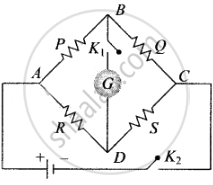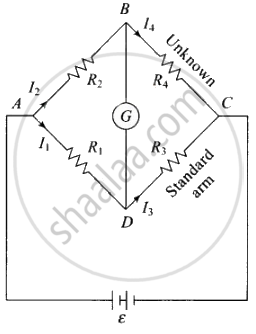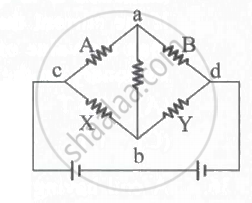Advertisements
Advertisements
प्रश्न
The measurement of an unknown resistance R is to be carried out using Wheatstones bridge (figure). Two students perform an experiment in two ways. The first students takes R2 = 10 Ω and R1 = 5 Ω. The other student takes R2 = 1000 Ω and R1 = 500 Ω. In the standard arm, both take R3 = 5 Ω. Both find R = `R_2/R_1 R_3` = 10 Ω within errors.
- The errors of measurement of the two students are the same.
- Errors of measurement do depend on the accuracy with which R2 and R1 can be measured.
- If the student uses large values of R2 and R1, the currents through the arms will be feeble. This will make determination of null point accurately more difficult.
- Wheatstone bridge is a very accurate instrument and has no errors of measurement.
पर्याय
a and b
b and c
c and d
a and d
उत्तर
b and c
Explanation:
Wheatstone bridge: The bridge is an arrangement of four resistance which can be used to measure one of them in terms of rest. Here arms AB and BC are called ratio arm and arms AC and BD are called conjugate arms.

Balanced bridge: The bridge is said to be balanced when deflection in the galvanometer is zero, i.e. no current flows through the galvanometer or in other words VB = VD. In the balanced condition `P/Q = R/S`, on mutually changing the position of cell and galvanometer this condition will not change.
Unbalanced bridge: If the bridge is not balanced current will flow from D to B if VD > VB, i.e. (VA – VD) < (VA – VB) which gives PS > RQ.
According to the problem for first students, R2 = 10 Ω, R1 = 5 Ω, R3 = 5 Ω
For second student, R1 = 500 Ω, R2 = 1000 Ω, R3 = 5 Ω
Let us take R4 = R.
Now, according to the Wheatstone bridge rule,
`R_2/R_1 = R_4/R_3` ⇒ `R_4 = R_3 xx R_2/R_1`
Now putting all the values in above equation, we get R = 10 Ω for both students. Thus, we can analyse that the Wheatstone bridge is most sensitive and accurate if resistances are of the same value.
Thus, the errors of measurement of the two students depend on the accuracy and sensitivity of the bridge, which in turn depends on the accuracy with which R2 and R1 can be measured.
The currents through the arms of bridge is very weak when R2 and R1 are larger.
This can make the determination of null point accurately more difficult.

APPEARS IN
संबंधित प्रश्न
Explain with a neat circuit diagram how will you determine unknown resistance ‘X' by using meter bridge
In a metre bridge experiment. the ratio of the left-gap resistance to right gap resistance is 2: 3. The balance point from the left is ______.
In the Wheatstone bridge, (shown in the figure) X = Y and A > B. The direction of the current between a and b will be ____________.

In the measurement of a resistance by the Wheatstone bridge, the known and the unknown resistance are interchanged to eliminate ____________.
In the meter bridge experiment, the null point is obtained at a distance of ℓ from the left end. The resistance in the left and right gaps are halved and then interchanged. The new position of the null point is at ______
In a balanced metre bridge, 5 Ω is connected in the left gap and R Ω in the right gap. When R Ω is shunted with equal resistance, the new balance point is at 1.6 I1 where 'I1' is the earlier balancing length. The value of 'I1' is ______
In a metre bridge experiment, the ratio of the left-gap resistance to right gap resistance is 2: 3. The balance point from the left is ______.
Draw a neat labelled diagram to determine unknown resistance using a meter bridge.
Find the radius of the wire of length 25m needed to prepare a coil of resistance 25Ω. (Resistivity of material of wire is 3.142 x 10-7Ωm)
Four resistances 4Ω, 4Ω, 4Ω and 12Ω form a Wheatstone's network. Find the resistance which when connected across the 12Ω resistance will balance the network.
